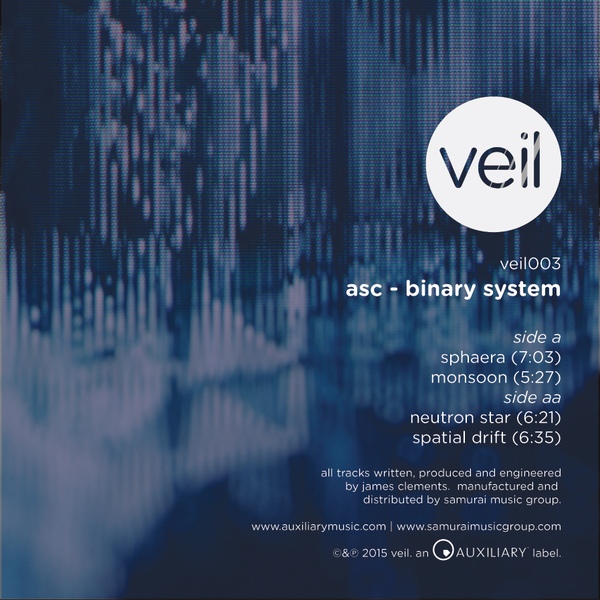Bandcamp // Discogs // Tumblr // Samurai Music
Se siete interessati alle novità in campo di sperimentazione della musica elettronica negli ultimi anni, dovete assolutamente prestare la vostra attenzione a prolifici produttori come James Clements, aka ASC.
La sua infinita discografia (circa in quindici anni di lavoro) dimostra l’ispirazione e la devozione dell’artista nei confronti della produzione musicale, con idee che spaziano dallo scisma drum’n bass seguente al progetto Autonomic, alle progressioni di synth per paesaggi ambient su Silent Season, della quale ne è inoltre il producer più attivo. Nel 2000 fonda la label Covert Operations Recordings (orientata all’atmospheric drum’n bass) chiudendola nel 2009. Successivamente inizia Auxiliary (2010) con le sue sottolabel Veil (2012) e Diode (2013). Spalla e partecipante attivo della ‘Samurai Horo‘ di Geoff Wright (aka Presha, boss della Samurai Music), in questi anni l’attività intensa e le idee dell’artista stanno avendo un ruolo centrale negli esperimenti ritmici e melodici a 170 bpm, oramai inaffiancabili al movimento inglese da cui originano e considerabili come musica di una scena nuova a tutti gli effetti.
Una delle sue ultime produzioni che ha ulteriormente marcato questa separazione esce come EP su Veil ad ottobre 2015: Binary System. La multidimensionalità di questo lavoro invita ad un ascolto attivo e conscio per la presenza di perpetui ritmi incalzanti e progressive pareti sonore, le quali cercano di descrivere l’assenza di limiti dimensionali dell’universo e della mente, oggetto di studio e tormento umano fin dal principio del suo avvento sulla terra. La corsa a 170 bpm predomina il viaggio astrale di Binary System, che ci lascia godere di una vista a 360° del panorama musicale che ASC vuole descriverci.
- Sphaera
- Monsoon
- Neutron Star
- Spacial Drift
Il trasporto istantaneo di Sphaera possiede l’immediata propulsione che ci proietta nella direzione che seguiremo durante i prossimi 26 minuti: meno di 100 secondi per realizzare che siamo già stati trascinati nello spazio ignoto. Non ci sono regole, non ci sono canoni, possiamo soltanto osservare ciò che ci si para d’innanzi. Mentre fluttuiamo in miscele gassose, siamo accolti nell’armonia della galassia da morbide velature atmosferiche di sintetizzatore, il nostro cammino levitante è ritmato dalla lineare locomozione del beat. L’accento è posto su un sample secco e sull’hi-hat, grazie ai quali il minimo dettaglio digitale dei lontani riverberi cibernetici non viene perduto. Monsoon divampa con un profondo respiro equatoriale e pesanti vampate di umidità. La frustata si sposta sul levare, l’apertura dell’hi-hat risveglia la vivacità collisoria degli atomi che ci circondano. Compare poi una cupa bassline lievemente distorta, sulla quale si materializza una turbinica danza di corteggiamento. Avventurosi lead di archi innalzano i protagonisti della sconcertante coreografia in un astratto dancefloor di dimensioni infinite. Un piccolo puntino di luce bianca si espande, come la più scura alba osservata da una vetta altissima. Il beat sferragliato, accompagnato da rimbalzi di basso fuzzato, anticipa il collasso, che improvvisamente si blocca assieme ad ogni suono, per poi esplodere dolcemente.
Da astronomica distanza di sicurezza, ammiriamo al rallentatore l’apparentemente lento scoppio di Neutron Star. Tuttavia, la potente liberazione energetica smentisce le nostre aspettative di restarne incolumi, facendoci deragliare dal nostro percorso. Sul movimento di una galoppante bassline continua, enunciata da un doppio kick, perdiamo la nostra orbita. I brevi attacchi di synth aggiungono una dimensione percussiva, e ospitano il cullante laboratorio di suoni psichedelici incantati che si presentano nella progressione della traccia. La caduta viene lentamente attutita. La potenza sprigionata dalla formazione della stella di neutroni si è stabilizzata e non ci spinge ulteriormente. Al termine di Spacial Drift resta soltanto una leggera brezza a seguito del taglio di ritmo e sintetizzatori, lasciandoci un calore sfumante e la sospensione nel vuoto.
L’ampia gamma sonora di Binary System riesce ad unire elementi caratteristici del percorso artistico di ASC, quali: l’aspetto esplorativo in chiave ambient (si vedano i paesaggi iperdettagliati di cui si può godere nelle produzioni su Silent Season); i 170 bpm come punto di partenza della sperimentazione minimal-drum’n bass sviluppatasi dopo gli anni di Autonomic; l’introspettivo tormento tipico dei percorsi più vasti della techno, sia dal punto di vista melodico che di sviluppo ritmico. Un grosso dibattito potrebbe sorgere riguardo alla possibile catalogazione di produzioni come questa nella categoria ‘musica da dancefloor’. Sicuramente il modo migliore per goderne è con delle buone cuffie o un ottimo soundsystem, riuscendo in questo modo a sperimentare l’energica esperienza di immersione che della musica così complessa può offrire. Non possiamo che seguire con altissime aspettative il movimento musicale che si sta definendo grazie alle idee di producer come ASC e degli artisti arruolati tra le fila delle loro etichette.
ENGLISH VERSION
Translation by Andrea Migliorati
If you’re interested in fresh approaches in the field of experimental eletronic music, you must focus your attention on prolific produces such as James Clements, aka ASC.
Bandcamp // Discogs // Tumblr // Samurai Music
Its endless number of releases (covering about 15 years) show how much the artist have been committed to musical production, jumping from the d’n’b-side on Autonomic, to synth/ambient progression on Silent Season (he is currently the most active producer on that label). ASC founded Covert Operations Recordings in 2000, an atmospheric d’n’b-oriented outcome, and closed it in 2009. In 2010 he started Auxiliary, together with its sub-labels Veil (2012) and Diode (2013). He’s a lively supporter of ‘Samurai Horo‘ collection by Geoff Wright (aka Presha, Samurai Music‘s boss) too. In these recent years, ASC’s style and vision revealed to be crucial in experimenting with rhythms and melodies at 170 bpm, causing a neat separation of ‘his’ musical current from the original UK movement he’s coming from, defining a brand new scene to all intents and purposes.
Among his latest releases – stressing this division of the scenes – we would like to talk about Binary System, a record out on Veil the last October. The EP offers a multi-dimensional, complex experience forcing the user to a deep, focused listening. The relentless rhythmic patterns and soundscapes provide a portrait of the Universe seen though a Human sensory apparatus. The 170 bpm tour-de-force predominates the interstellar-travel featured in Binary System. This release allow us to enjoy a 360° view on the producer’s take on music he plays through the record.
- Sphaera
- Monsoon
- Neutron Star
- Spacial Drift
The sudden energetic pulse of Sphaera instantaneously takes us on the path we’re about to follow in the following 26 minutes of hard listening: less than 100 seconds to realize we’re already travelling in deep space. There are no regulations nor limits, the only thing we could do is to enjoy the breath-taking view. While fluctuating in vanishing clouds, the armony of the galaxy embraces us through shades of synth, our levitation is guided by the linear stride of the beat. The focus is on a dry sample and on the hi-hat: they allow us to catch every single detail of the echoing, cibernetic reverberations. Monsoon erupts with its heavy and hot equatorial dampness. The whiplash moves on the hi-hat’s lift, which causes the atoms surrounding us to get lively, and to collide with the others. Then, a quietly-distorted, deep bassline fades in; on it, a swirly courtship dance takes place. Adventurous string leads elevate the characters involved in the overwhelming choreography towards a dancefloor of infinite size. A tiny white-light spot appears and spreads, such as the darkest sunset observed from a high mountain peak. The rattling beat, together with bouncings of fuzzed bass, anticipates the clash of sounds, which surprisingly stops, to softly and silently explode few instants further on.
Then, we are brought to catch (hear) the view of the explosion pictured in Neutron Star. Appearently very quiet, the outburst of energy takes us unprepaired and make us derail from the expected trajectory. Moving on the hues of a galloping, enhanced-by-a-double-kick bassline, we miss our orbit. The short synth hooks manages to add a percussive layer to the structure of the music, which evolves hosting a cauldron of psychedelic, enchanted sounds. The fall gets attenuated, the power caused by the birth of the neutron star levels off and does not push us no more. What remains at the end of Spacial Drift, following the cut of the main rhythmic pattern and of the synths, is just a pleasant breeze, that leaves us suspended in the void with a fading sense of warmth.
The huge variety of sounds featured in Binary System manages to combine efficiently different typical characteristics of the producer’s musical production, such as: the ambient explorations (see the iper-detailed soundscapes on Silent Season); the assumption of the 170 bpm as the starting step for the evolution of the minimal-drum’n bass genre developed during the Autonomic years; finally, the inward, tormented look on the self, both considering the rhythm patterns and the melody too, which is somehow a characteristic of some ‘techno’-er musical paths. A very interesting debate could be started about the possibility to label musical productions like Binary System EP as ‘dancefloor music’. The only thing we’d like to state is that the best way to listen to the music is through the best soundsystem one could find: this would hopefully lead to experience the vigorous take a very-deeply-structured type of music like this could offer. We can’t help but actively follow the musical movement which is being defined right now thanks to bright, original ideas developed by producers like ASC and the other artists who joined their label’s rosters.
Are you enjoying what you see on PAYNOMINDTOUS? If that’s the case, we’d like to kindly ask you to subscribe to our newsletter, our Facebook group, and also to consider donating a few cents to our cause. Your help would be of great relevance to us, thank you so much for your time!
PAYNOMINDTOUS is a non-profit organization registered in December 2018, operating since late 2015 as a webzine and media website. In early 2017, we started our own event series in Turin, IT focused on arts, experimental, and dancefloor-oriented music. We reject every clumsy invocation to “the Future” meant as the signifier for capitalistic “progress” and “innovation”, fully embracing the Present instead; we renounce any reckless and ultimately arbitrary division between “high” and “low”, respectable and not respectable, “mind” and “body”; we support and invite musicians, artists, and performers having diverse backgrounds and expressing themselves via variegated artistic practices.


